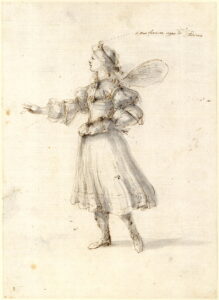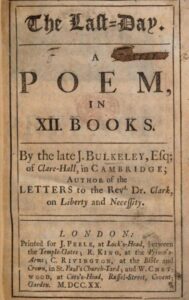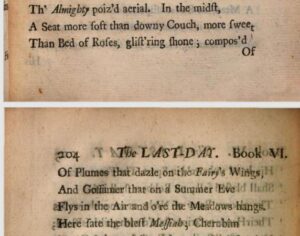Early New Fairy Wing Reference February 1, 2023
Author: Beach Combing | in : Modern , trackbackRegular readers will know that I have long had an interest in fairy wings. There have been several posts and even an article in 2019. I have tried to defend a position that fairies get wings i) in Britain; and ii) that this happens in the late eighteenth century. Certainly, when I did my research I found no unequivocal examples of fairies with wings before the 1780s. I even tried to make, very gently, the case that William Blake (himself a fairy seer) created the Tinkerbell model. However, as I discussed, this month, the invention of fairy wings with Chris on the Boggart and Banshee podcast a new bit of information emerged. I say ‘emerged’. It was actually lobbed at me by Chris while I was pontificating about late eighteenth-century artists. Chris has come across a prose reference to fairy wings from 1720 in The Last Day: A Poem in XII. Books by J. Bulkeley.*
Bulkeley died of consumption in 1718 aged twenty-four.
The poem seems to have been written towards the end of his life. Indeed, Bulkeley apparently believed that the Last Day had helped kill him. In his editor’s words: Bulkley ‘shook his Head, and intimated that those Papers had shorten’d his Days’. Perhaps then we can say that the (very long) poem was actually written c. 1717?
The lines, in any case, are as follows.
Th’ Almighty poiz’d aerial. In the midst,
A Seat more soft than downy Couch, more sweet
Than Bed of Roses, glist’ring shone; compos’d
Of Plumes that dazle on the Fairy’s Wings,
And Goissimer tha on a Summer Eve
Flys in the Air and o’re the Meadows hangs.
I had – if I’m honest – hoped to find that Chris had uncharacteristically got a too early date, or that the reference had some ambiguity. But the date is actually a couple of years earlier than she suggested (see above); and I can’t find any possible way to read this screed that doesn’t involve a fairy with wings.
Of course, I can still point to all the references (visual and written) to fairies without wings from this period and earlier. I can also point to the likely influence of Alexander Pope whose winged sylphs were becoming famous in these years.
I keep, however, getting distracted by thoughts of poor Bulkeley coughing spots of blood into his handkerchief. His name would be ‘writ on water’, but perhaps there was a foolish hope that his Last Day might earn him some immortality? The only immortality the fellow gets, though, comes three hundred years later, on a fractious fairy podcast in an argument about two words he had written. It is enough to make you hope there is no afterlife…
I’ll be putting up some of Chris’s ‘problematic’ early references to wings at the Boggart and Banshee Facebook page through this month. But she definitely gets a point for Bulkeley, curse her. If anyone can prove her wrong or me wronger: drbeachcombing AT gmail DOT com
*J. is taken as ‘John’ by various library catalogues. I have not seen any evidence of this.






